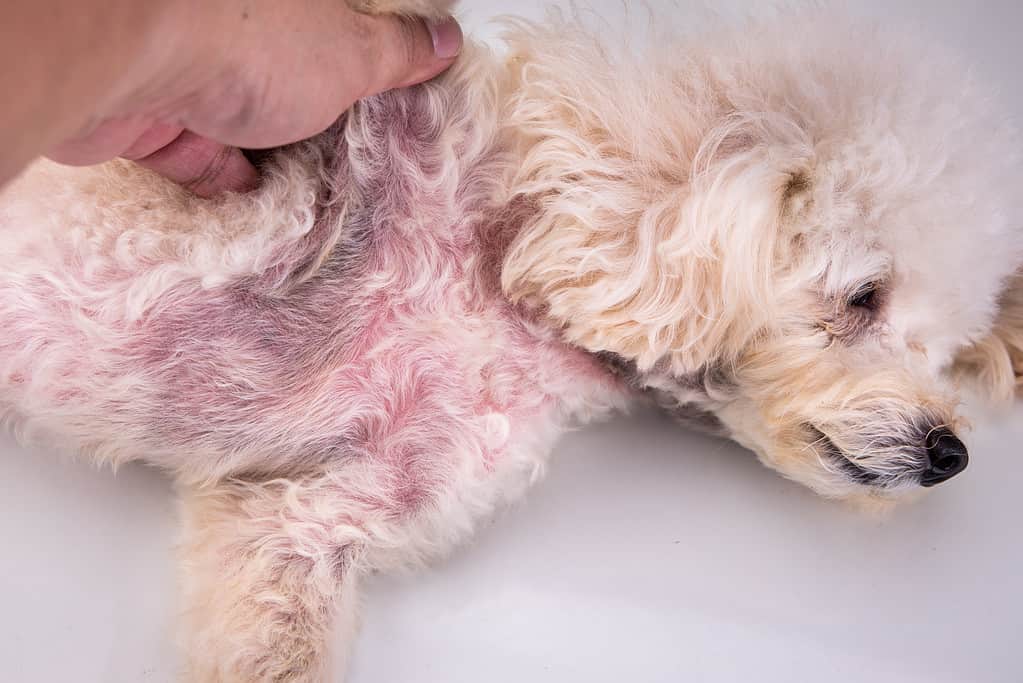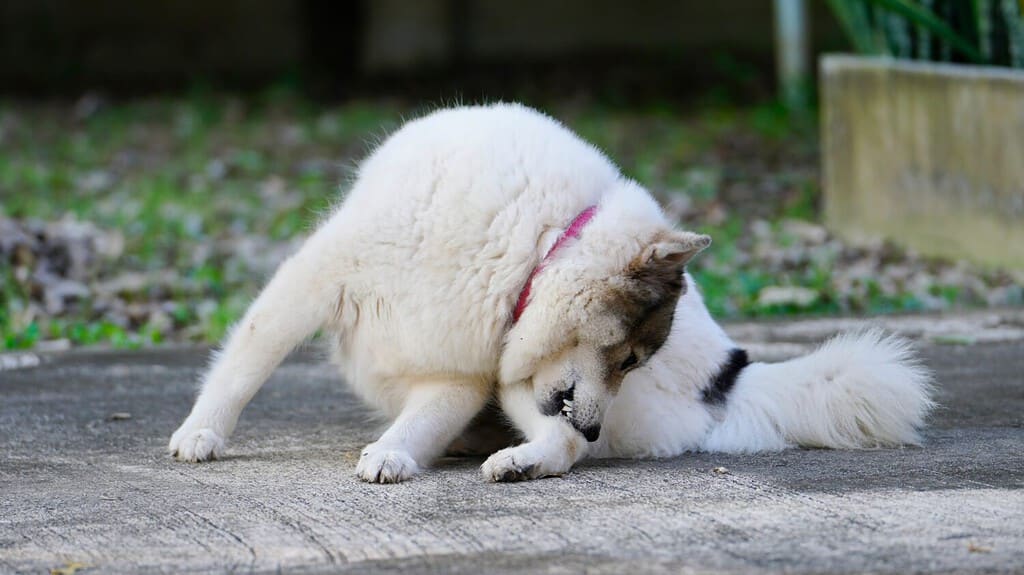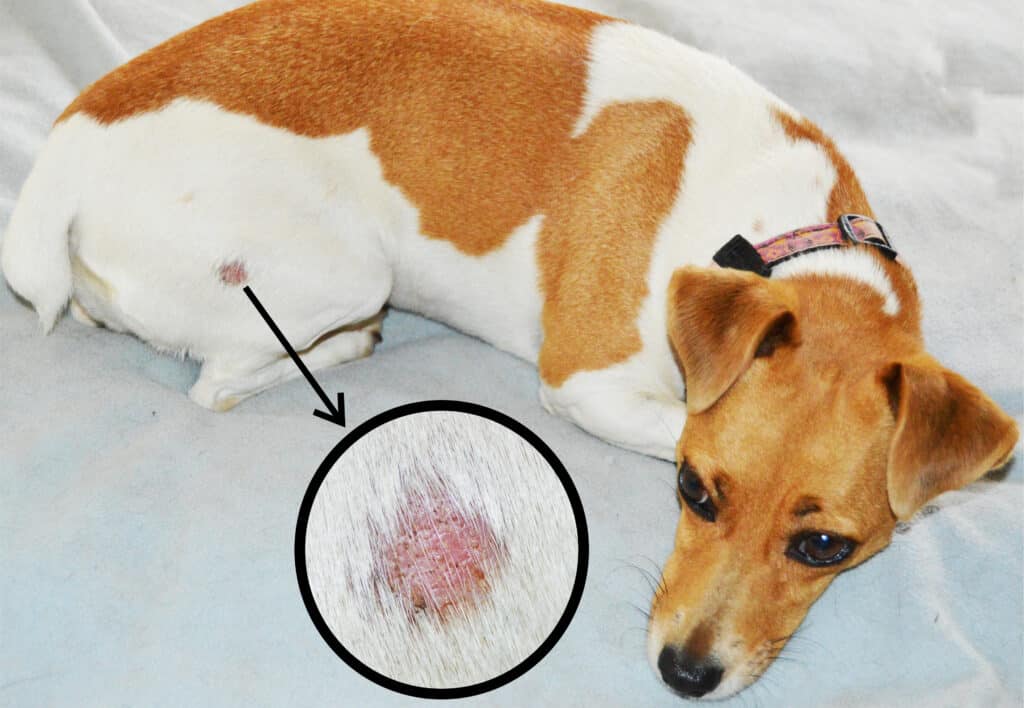Skin infections are a common and irritating problem for our pets. Dogs, like humans, are prone to a range of skin infections that can cause discomfort and anxiety. Bacteria, fungi, parasites, allergies, and even underlying medical disorders can cause these diseases.
Identifying the signs and symptoms of skin infections in dogs is essential for quick intervention and treatment. Understanding the various skin infections affecting dogs is pivotal for preserving their overall health and well-being.
Did you know that dogs can contract skin infections just like people? Our furry companions depend on us to maintain their well-being and joyfulness. Skin infections affecting dogs can stem from several culprits, such as:
- Bacteria
- Fungi
- Parasites
- Allergies
These ailments produce an irritating sensation and itchiness in our four-legged friends. It also puts them in danger of more severe health complications. This article delves into the different types of skin infections that may target dogs.
From common disorders like hot spots and yeast infections to more severe cases of pyoderma or mange, in this post, we’ll look at the several types of skin infections that can arise in dogs. We will also delve deep into their origins, symptoms, and treatment choices. This knowledge will help you better diagnose and treat these concerns in your four-legged friend.
How to Spot a Dog With a Skin Infection
Dog skin conditions can present themselves in the following ways:
- Itching: If your furry companion spends excessive time scratching, biting, or licking their skin, it may indicate a problem. This might be caused by various factors such as fleas, lice, etc.
- Flaking: When dogs experience flaking, their skin produces too many dead cells resulting in white or gray flakes on the coat. Flaking may hint at seborrhea (a condition that affects the oil glands in the skin), dandruff caused by dryness, or even fungal infections.
- Odor: Detecting an unpleasant or foul scent could indicate a bacterial or yeast infection. Such infections can give rise to various issues on the skin, such as inflammation, discharge, crusts, or scabs.
- Lumps: Inspect for lumps or protrusions on their sensitive dermis. These bumps may manifest as harmless (non-cancerous) growths or malignant (cancerous) tumors. Some might feel soft and movable when touched, while others may be firm and immobile.

Dog skin infections can present as itching, flaking, odor, and lumps. Be sure to check for these signs if you suspect that your pup is ill.
©Mary Swift/Shutterstock.com
Common Skin Infections in Dogs
Lyme Disease
Lyme disease is caused by Borrelia burgdorferi bacteria transmitted through bites of infected black-legged ticks (deer ticks) to humans and animals. In dogs, there exist various manifestations of Lyme disease. The most prevalent signs include:
- Limping
- Swollen lymph nodes
- Joint swelling
- Fatigue
- Loss of appetite
In severe instances, this condition can lead to kidney problems in canines. However, only a tiny percentage (roughly 5-10%) of infected animals demonstrate noticeable symptoms associated with Lyme disease.
When it comes to controlling this ailment, preventing tick bites is crucial. Several options exist to combat this problem, including sprays and monthly oral or spot-on treatments designed specifically for dogs. Vaccines are also available as an effective preventive measure against Lyme infection in canines.
For the treatment to work optimally, it’s best to administer vaccines before exposing your dog to Lyme-causing bacteria. If you reside in an area endemic with this disease, your veterinarian will likely recommend vaccination and booster shots for your loyal companion.
Treatment of Lyme Disease
Antibiotics are typically prescribed to dogs suffering from Lyme disease for approximately four weeks. While most canines with limb and joint issues respond positively to treatment, there are cases where symptoms persist even after the completion of antibiotics.
In such situations, another round of treatment is usually required as the infection may still be present despite prior medication. Administering additional therapies to support affected organs and manage any lingering symptoms is imperative.
Sadly, some dogs may experience chronic joint pain throughout their lives due to bacterial damage caused by Lyme disease.

Early detection of skin infections in dogs is important for effective treatment. Signs of infection may include redness, sores, rashes, loss of hair or fur, as well as inflammation.
©ThamKC/Shutterstock.com
Mange
Mange is a skin infection from little mites dwelling in the hair follicles. It consists of two primary variations: sarcoptic mange and demodectic mange.
Sarcoptic mange, also identified as scabies, is less prevalent and generally impacts forsaken canines or those with weakened immune systems. It has the potential to be transmitted from dogs to humans. On the other hand, demodectic mange, commonly referred to as red mange, tends to transfer between a mother dog and her nursing puppies during feeding but doesn’t spread between canines nor infect humans.
Symptoms of mange typically involve:
- Intense itching
- Hair loss
- Lesions originating from excessive scratching
- Raised bumps primarily witnessed on the chest region
- Scaly skin is regularly observed alongside ears’ perimeters and at the elbows, ankles, armpits, and elbows
Treatment of Mange
If your pet is suffering from mange, cleaning their bedding is crucial while keeping other animals away from contact with the affected pet. Veterinary diagnosis of mange involves examining a sample of the affected skin under a microscope.
Treatment options require administering tablets alongside specialized shampoos that kill the mites. These relieve itching and inflammation. Certain flea and worm products can also safeguard against mange infection.

Mange is one of the most common skin infections in dogs, which requires veterinary care and specific treatments.
©iStock.com/Thanawath Seangsuriyapone
Yeast Infection
A yeast infection manifests when an overabundance of yeast resides on a dog’s body. As budding and spore-like forms of fungi, yeast usually inhabits the body without causing harm. However, issues arise when their numbers increase significantly.
Yeast thrives in moist environments, which means dogs can be susceptible to infections in areas such as the ears, groin, armpits, and paws. In certain breeds with folds on their faces, these creases also serve as breeding grounds for yeast growth. While a veterinarian can confirm the diagnosis with certainty, pet owners should watch for specific symptoms.
- Skin color and texture: During the early stages of a yeast infection, the skin may turn pink or red. When dealing with chronic conditions, the affected area may become leathery, thickened, or even display shades of gray or black.
- Greasy skin: The infected area might appear unusually oily or excessively weathered.
- Scaly skin: Occasionally, dogs may develop scaly skin alongside scaling or flakiness similar to dandruff.
- Head tilting and shaking: Pay close attention if your dog shows signs like head shaking and tilting since yeast infections commonly impact ears.
- Constant scratching: Yeast infections provoke significant itchiness, prompting dogs to search for relief by scratching against surfaces like flooring or furniture.
- Licking: Licking the infected area persists as another method dogs employ to soothe their discomfort caused by stressful itching sensations.
- Inflammation: Swelling associated with a yeast infection often leads to inflammation accompanied by warmth within the site of infection. It initially manifests as redness but progresses into painful swelling over time.
- Odor: An unmistakable sign of a yeast infection is odor. It is the first clue that something is amiss. If you detect a musty or cheesy stench emanating from your dog, this indicates yeast infection.
- Hair loss: Yeast infections can make a dog itchy and lose fur near the ear parts.
- Drooling: Rare yeast infections can occur within a dog’s mouth, resulting in problems like drooling and difficulties associated with eating. It is crucial to consult a veterinarian to diagnose whether your case is a yeast infection or another oral issue.
Treatment of Yeast Infection
Imagine your dog has a yeast infection in their ears. In that case, the veterinarian will likely recommend a combination of ear cleansing and topical medication specifically designed for the ears. Additionally, the vet may prescribe a medicated lotion or cream that should be applied once or twice daily following ear cleaning.
Various treatment methods are available in cases where dogs experience yeast infections on their skin. The vet might recommend oral anti-yeast medication as one option. However, topical treatments like anti-yeast creams, lotions, shampoos, or wipes also prove effective alternatives.
When dealing with a canine suffering from a yeast infection on their paws, using medicated wipes or lotions can bring about desirable results.
If your pet has a widespread skin yeast infection throughout its body, your vet may consider prescribing shampoo containing ketoconazole.

Yeast infections can cause discomfort and even put your dog at risk of other infections. Get help from your vet if you suspect a problem, and they’ll guide you on treatment options.
©KPhrom/Shutterstock.com
Impetigo
Canine impetigo is frequent in young dogs who have not yet reached puberty. It often appears when they’re living in unsanitary conditions. Impetigo manifests as a skin problem with pockets of pus beneath the skin’s surface caused by specific bacteria. Bullous impetigo is a distinct condition seen in older dogs. Old dogs with serious illnesses or hormonal imbalances like diminished thyroid function are more prone to impetigo.
Unlike human impetigo, canine impetigo is not contagious. As long as the root causes are addressed and the sores receive prompt treatment, this condition generally poses no threat. Impetigo can emerge on various areas of a dog’s exposed skin without fur. These include the belly, groin, and junctions where the legs join the body (similar to the armpits). The extent of the condition relies on the dog’s physique and coat type.
The primary indication of impetigo is small bumps that resemble acne on the dog’s skin. These bumps may also be accompanied by redness and irritation. In some severe cases, more prominent blisters may be filled with pus rather than standard pimples. In some instances, there might be neither blisters nor pimples. Instead, affected regions will exhibit scaly patches with a crusty texture.
Treatment of Impetigo
Before treating impetigo in dogs, vets generally conduct tests to rule out ringworm and mange mites. Additionally, they examine a sample of the affected skin area as confirmation of impetigo.
Occasionally, impetigo may resolve naturally without requiring antibiotics. If your vet believes this might occur in your dog’s case, they may suggest using an anti-itch cream to alleviate irritation while allowing nature to take its course.
However, some veterinarians are uncomfortable with allowing impetigo to clear up spontaneously. They typically prescribe topical antibiotics and an antiseptic wash as treatment options. The topical antibiotic comes as an ointment or cream for application onto affected areas, while the antiseptic wash takes shape as a shampoo designed to help fight off infection.
Ringworm
Contrary to its name, ringworm doesn’t stem from worms. It’s a fungus that resembles the one responsible for Athlete’s foot. This particular fungus generates tough spores that are difficult to eradicate from the environment. These spores possess endurance and can last many years. A single spore is sufficient to trigger an infection. However, it’s worth noting that only broken skin has the potential to be infected. Therefore, dogs with healthy skin won’t contract ringworm.
In canines, ringworm manifests in multiple forms. The most prevalent signs include patches of hair loss hidden beneath a crusty layer. Sometimes, there are no noticeable symptoms at all. In some cases, these affected areas may exhibit gray and scaly patches, while in others, they take on the appearance of reddened sores.
Acknowledging that many other skin conditions mirroring ringworm occur more frequently is essential. Ringworm infections target young, old, or long-haired dogs more than others. Ordinarily, lesions caused by this ailment materialize predominantly on a dog’s head, paws, ears, and legs. However, they can appear elsewhere on their body.
Treatment of Ringworm
The standard method for addressing ringworm in canines involves administering shampoos, creams, and ointments directly to the affected regions. At the same time, provide the animal with antifungal medications orally. The crucial task of ensuring contamination eradication also entails cleansing the environment. Your veterinarian may conduct periodic tests to assess if your furry companion remains infection free.
It’s advised to only stop treatment after receiving a recommendation from your veterinarian. Prematurely halting the prescribed regimen may lead to a resurgence of fungal growth.
If you maintain many pets within your household, it’s advisable to segregate and treat the infected individuals separately. Treating all pets might prove more beneficial. Nevertheless, your veterinarian will provide guidance based on factors specific to your situation.

Ringworm is a common type of skin infection that can affect dogs. It usually manifests as circular patches of hair loss and dry, crusty skin.
©Nathalie Marran/Shutterstock.com
Heartworms
Heartworm disease is a grave condition afflicting pets, specifically dogs, cats, and ferrets. This illness gives rise to pulmonary disorders, cardiac failure, and organ impairment and can even result in mortality.
The culprit behind this ailment is a parasite named Dirofilaria immitis which spreads through the gnawing bites of mosquitoes. Primarily dwelling within dogs as their primary hosts, these worms proliferate inside the:
- Heart
- Lungs
- Blood vessels
Mosquitoes transport immature worms to other animals, acting as intermediary carriers for a brief period. Every state of the United States has reported cases of heartworms in pets. However, coastal regions from the Gulf of Mexico to New Jersey bear high rates of heartworm disease prevalence along with the Mississippi River vicinity.
Treatment of Heartworms
There are available treatments designed for heartworms. One such option is the drug called Melarsomine dihydrochloride, which goes by the brand names Immiticide and Diroban. This medication has received approval from the Food and Drug Administration (FDA). It’s administered by injecting it into the muscles at the dog’s back.
Advantage Multi for Dogs is another FDA-approved option to combat heartworm disease in dogs. It contains two active ingredients: imidacloprid and moxidectin. Its primary purpose is to target microfilariae present in the dog’s bloodstream. The product comes as a topical solution meant to be applied directly onto the skin of the affected dog.
Even with these available treatments, treating heartworm disease poses challenges for the dog. The process can harm the dog, as specific treatment components may have toxic effects on the body. Complications like life-threatening blood clots forming within their lungs may also arise during treatment.

Heartworm—a long, thin, thread-like worm—can cause serious damage if not treated quickly. Treatment includes the use of medications and preventative care.
©vitrolphoto/Shutterstock.com
Summing Up the Various Skin Infections Seen in Dogs
Dog owners need to be aware that dogs can contract various skin infections, which can cause discomfort and potentially lead to more severe health issues. Bacteria, fungi, parasites, or allergies can cause these infections. It is crucial to detect and treat the signs of a skin infection, such as itching, flaking, odor, or lumps. In managing these infections properly, correct diagnosis and treatment are paramount. Veterinarians may prescribe antibiotics, antifungal medications or recommend topical treatments like shampoos or creams.
Particular medications are available to eliminate worms in the case of heartworm disease, which potentially threatens a dog’s life. However, it would help if you remembered that the treatment process might sometimes be challenging and could have some side effects. By maintaining good hygiene practices in conjunction with keeping their living areas clean alongside adhering faithfully to preventive measures, dog owners can make rapid progress toward helping protect their furry friends from skin infections.
The photo featured at the top of this post is © Rattanapon Ninlapoom/Shutterstock.com
Ready to discover the top 10 cutest dog breeds in the entire world?
How about the fastest dogs, the largest dogs and those that are -- quite frankly -- just the kindest dogs on the planet? Each day, AZ Animals sends out lists just like this to our thousands of email subscribers. And the best part? It's FREE. Join today by entering your email below.
Thank you for reading! Have some feedback for us? Contact the AZ Animals editorial team.






